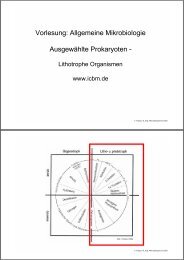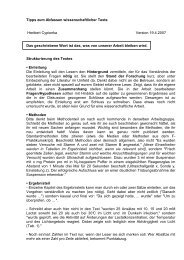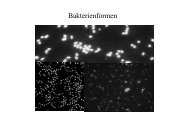Viruses (1) - ICBM
Viruses (1) - ICBM
Viruses (1) - ICBM
You also want an ePaper? Increase the reach of your titles
YUMPU automatically turns print PDFs into web optimized ePapers that Google loves.
<strong>Viruses</strong> (1)<br />
Eukaryotic microorganisms and viruses<br />
(WS 2010/2011)<br />
VIRUS (latin: poison)<br />
General term for all infectious agents!<br />
China 1000 B. C.<br />
Prevention without knowledge of the agent, based on<br />
recognition that survivors of smallpox were subsequently<br />
protected against disease<br />
Inoculation of healthy individuals with dry material from<br />
smallpox pustules (inhale).
Dimitri Iwanowski (1864-1920)<br />
Discovery of the tobacco mosaic disease (1892)<br />
Tobacco mosaic virus<br />
300 x 18 nm<br />
(+) ssRNA<br />
Genus: Tobamovirus<br />
Baltimore: class 4
Discovery of the tobacco mosaic disease (Iwanowski<br />
1892): Infectous agent of the tobacco mosaic disease<br />
passes through filter that retain bacteria.<br />
Contagium vivum fluidum (Beijerink1898): Suggested that<br />
the pathogen is a distinct living agent<br />
Agent of foot and mouth disease is filterable (Loeffler &<br />
Frosch 1898)<br />
Discovery of the first human virus, yellow fever virus (Reed<br />
1901)<br />
Discovery of bacteriophage (Twort 1915)<br />
Disvory of the first influenza virus in pigs (Schope1931)<br />
Significant impact of virology<br />
Medicine<br />
Sociology<br />
Genetic<br />
Biotechnology<br />
Ecology
General properties of viruses<br />
Size of virus particle (virion) varies between 20-300 nm<br />
General properties of viruses<br />
<strong>Viruses</strong> are obligate parasites<br />
They can not perform processes for energy conservation or<br />
for biosynthesis<br />
Replication occurs within a host (intracellular)<br />
Occur as nucleic acid in the host (intracelluar) or as virion<br />
(extracellular)<br />
Virions consist of a genome (DNA or RNA), capsid (protein<br />
coat), and often virus-specific enzymes<br />
Enveloped viruses are enclosed in a membrane (lipid<br />
bilayer)
General properties of viruses<br />
Structure of virions (extracellular state of viruses)<br />
General properties of viruses<br />
Nucleic acid can be either DNA or RNA
Classification of viruses<br />
Classical hierarchical system:<br />
Kingdom<br />
Phylum<br />
Class<br />
Order<br />
Family<br />
Genus<br />
Species<br />
International Committee on Taxonomy of viruses (ICTV)<br />
(http://phene.cpmc.comlumbia.edu)<br />
Classification of viruses<br />
Yet, 30,000 - 40,000 viruses are known<br />
<strong>Viruses</strong> are classified in accordance to four main<br />
characteristics:<br />
Nature of nucleic acid in virion<br />
Symmetry of protein shell (capsid)<br />
Presence or absence of lipid membrane<br />
Dimension of virion and capsid<br />
Genomic has also become important
Classification of viruses<br />
RNA viruses<br />
Classification of viruses
Classification of viruses<br />
DNA viruses<br />
Classification of viruses
Classification of viruses<br />
Baltimore classification (focus on synthesis of mRNA)<br />
(+) strand can be directly translated<br />
(-) strand cannot be translated<br />
Combination of<br />
a) type of viral genome and<br />
b) information about genome synthesis<br />
Classification into six distinct virus groups<br />
Classification of viruses<br />
Formation of mRNA after infection of cells by viruses<br />
In general, RNA polymerases use double-stranded DNA!
Structure of viruses<br />
Structural units of virions<br />
Subunit (single folded polypetide chain)<br />
Protomer (structural unit, one or more subunits)<br />
Capsomer (surface structure)<br />
Capsid (protein coat/shell)<br />
Nucleocapsid (core, nucleic acid-protein assembly within<br />
virion)<br />
Envelope (viral membrane, host-derived lipid bilayer)<br />
Virion (extracellular infectious viral particle)<br />
Structure of viruses<br />
Function of virion proteins<br />
Protection of the genome<br />
Self assembly of a stable, protective protein shell<br />
Specific recognition and packaging of the genome<br />
Interaction with host cell membranes to form envelope<br />
Delivery of the genome<br />
Binding to host cell receptors<br />
Transmission of signals that induce uncoating of the genome<br />
Induction of fusion with host cell membranes<br />
Interaction with cell components to direct transport of genome<br />
to appropiate site<br />
Protection of the genome<br />
Other interaction with host
Structure of viruses<br />
Electron microscopy (50-75 Å)<br />
(Ruska 1940, First picture of virus particles:<br />
Sichtbarmachung der Bakterienlyse im Übermikroskop,<br />
Naturwissenschaften 28)<br />
Biological materials have only little inherent contrast;<br />
staining necessary.<br />
Negative staining with electron-dense material (uranyl<br />
acetate, phosphotungstate)<br />
But, detailed structural interpretation impossible<br />
Cryo electron microscopy (8-20 Å)<br />
X-ray crystallography (2-3 Å)<br />
3 dimensional structures<br />
Structure of viruses
Structure of viruses<br />
Structure of viruses<br />
Helical structure of the Tobacco mosaic virus<br />
(Genus Tobamovirus)<br />
Arrangement of ss RNA and capsid<br />
by self-assembly<br />
100 nm
Structure of viruses<br />
Icosahedral structure of a human papilloma virus (HPV)<br />
(Genus Papillopma virus)<br />
ds circular DNA<br />
Common infection disease,<br />
transmitted by sexual contact.<br />
55 nm in diameter<br />
Cubic symmetry<br />
Penton Capsomer<br />
(surronded by 5)<br />
Hexon Capsomer<br />
(surronded by 6)<br />
Rotation symmetry:<br />
2-,3-,5-fold symmetry<br />
.
Structure of viruses<br />
Structure of viruses<br />
Complex structure of a vaccinia virus (poxvirus, ds DNA)<br />
Replication in host cytoplasm
Virus multiplication<br />
•Attachement (adsorption) of the virion to susceptible host cell<br />
•Penetration (injection) of the virion or its nucleic acid into the<br />
host<br />
•Control of host cell biosynthetic machinery<br />
•Replication of virus nucleic acid<br />
•Synthesis of viral protein and morphogenesis (assembling<br />
and packaging)<br />
•Release of mature virions from the host cell (lysis)<br />
Virus multiplication<br />
Possible effect of animal viruses on infected cells
Classification of viruses<br />
Main types of prokaryotic viruses<br />
Virus multiplication<br />
Principal replication cycle of a bacterial virus
Virus multiplication: Attachment of T4 bacteriophage to the cell wall<br />
Virus multiplication<br />
Infection<br />
by<br />
a temperate<br />
Bacteriophage<br />
(e.g. lambda)
Phage Induction Experiments<br />
DNA damage via the antibiotics "Mitomycin C"<br />
induces the assembly of phages<br />
2<br />
Mitomycin C<br />
Control<br />
1.5<br />
OD 600<br />
1<br />
washing steps<br />
0.5<br />
incubation<br />
addition of mitomycin C<br />
0<br />
0 5 10 15 20 25<br />
Time [h]<br />
Rhizobium radiobacter strain P007<br />
ODP Site 1225, depth: 198 mbsf<br />
www.pmbio.icbm.de<br />
Control<br />
Mitomycin C<br />
19 hours<br />
Control: no counts of VLPs<br />
Mitomycin C: 1.2 x 10 10 VLPs/ml<br />
Bert Engelen<br />
Phage Gallery<br />
a Phage heads inside a cell of<br />
R. radiobacter<br />
b Phage attached to the cell<br />
surface of R. radiobacter<br />
c Free phage particles induced<br />
from Rho. capsulatus<br />
Myoviruses from<br />
d1/2 R. radiobacter<br />
e V. diazotrophicus A<br />
f V. diazotrophicus B<br />
Siphoviruses from<br />
g P. glucanolyticus<br />
h Rhb. capsulatus<br />
i Rhv. sulfidophilum<br />
www.pmbio.icbm.de<br />
bars 100 nm<br />
Bert Engelen
Virus multiplication<br />
One step growth curve of virus replication<br />
Virus multiplication<br />
Time course of events after T4 infection
Plaque assay using the agar overlay technique<br />
Plaques are 1-2 mm in diameter<br />
Virus multiplication<br />
Rolling circle replication of phage lambda
Viroids and Prions<br />
Viroids<br />
Small, circular, ss RNA molecules<br />
Represent smallest known pathogens (in plants)<br />
Extracellular form has no capsid, just naked RNA<br />
Has been proposed as relict from a “RNA world”<br />
Contain no protein coding sequences<br />
Transmitted by seed or pollen<br />
Viroids and Prions<br />
Prions (Proteinaceous infectious particle)<br />
- Extracellular form consist of protein<br />
- Particles are infectious and cause a variety of diseases in<br />
animals: scrapie (in sheep) Creutzfeldt-Jacob disease<br />
(human), bovine spongiform encephalopathy (cows,BSE)<br />
- All of those diseases affect brain or neural tissue<br />
- Prions interact with similar host protein resulting in<br />
modification of folding and finally loss of function<br />
Still unclear how prions introduce production of the<br />
pathogenic protein itself
















